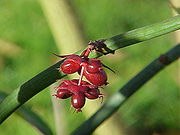
Leycesteria formosa
Encyclopedia
Leycesteria formosa is a deciduous shrub in the family Caprifoliaceae
, native to the Himalaya and southwestern China
. It is considered a noxious invasive species
in Australia, New Zealand, the neighboring islands of Macronesia, and some other places. It is not yet considered an noxious invasive species in Canada or the United States, but many plants with the common name "Honeysuckle" are.
The plant was named by Nathaniel Wallich
, director of the Calcutta Botanic Garden after his friend William Leycester, a judge in the native court in Bengal
It has soft, hollow, upright green stems 1-2 m tall, which only last for 2-5 years before collapsing and being replaced by new stems from the roots. The leaves
are opposite, dark green, 6-18 cm long and 4-9 cm broad, with an entire or wavy margin. The flower
s are produced on 5-10 cm long pendulous raceme
s; each flower is small, white, subtended by a purple bract
. The fruit
is a soft purple-black berry
1 cm diameter, eaten by bird
s which disperse the seeds.
L. formosa became a popular plant in Victorian shrubberies. Attempts have been made in recent years to repopularise the species in Britain with new cultivated varieties appearing in garden centres.

Caprifoliaceae
The Caprifoliaceae or honeysuckle family is a clade consisting of about 800 dicotyledonous flowering plants, with a nearly cosmopolitan distribution; centres of diversity are found in eastern North America and eastern Asia, while they are absent in tropical and southern Africa.They are mostly...
, native to the Himalaya and southwestern China
China
Chinese civilization may refer to:* China for more general discussion of the country.* Chinese culture* Greater China, the transnational community of ethnic Chinese.* History of China* Sinosphere, the area historically affected by Chinese culture...
. It is considered a noxious invasive species
Invasive species
"Invasive species", or invasive exotics, is a nomenclature term and categorization phrase used for flora and fauna, and for specific restoration-preservation processes in native habitats, with several definitions....
in Australia, New Zealand, the neighboring islands of Macronesia, and some other places. It is not yet considered an noxious invasive species in Canada or the United States, but many plants with the common name "Honeysuckle" are.
The plant was named by Nathaniel Wallich
Nathaniel Wallich
Nathaniel Wallich was a surgeon and botanist of Danish origin who worked in India initially in the Danish settlement near Calcutta and later joined the East India Company...
, director of the Calcutta Botanic Garden after his friend William Leycester, a judge in the native court in Bengal
It has soft, hollow, upright green stems 1-2 m tall, which only last for 2-5 years before collapsing and being replaced by new stems from the roots. The leaves
Leaf
A leaf is an organ of a vascular plant, as defined in botanical terms, and in particular in plant morphology. Foliage is a mass noun that refers to leaves as a feature of plants....
are opposite, dark green, 6-18 cm long and 4-9 cm broad, with an entire or wavy margin. The flower
Flower
A flower, sometimes known as a bloom or blossom, is the reproductive structure found in flowering plants . The biological function of a flower is to effect reproduction, usually by providing a mechanism for the union of sperm with eggs...
s are produced on 5-10 cm long pendulous raceme
Raceme
A raceme is a type of inflorescence that is unbranched and indeterminate and bears pedicellate flowers — flowers having short floral stalks called pedicels — along the axis. In botany, axis means a shoot, in this case one bearing the flowers. In a raceme, the oldest flowers are borne...
s; each flower is small, white, subtended by a purple bract
Bract
In botany, a bract is a modified or specialized leaf, especially one associated with a reproductive structure such as a flower, inflorescence axis, or cone scale. Bracts are often different from foliage leaves. They may be smaller, larger, or of a different color, shape, or texture...
. The fruit
Fruit
In broad terms, a fruit is a structure of a plant that contains its seeds.The term has different meanings dependent on context. In non-technical usage, such as food preparation, fruit normally means the fleshy seed-associated structures of certain plants that are sweet and edible in the raw state,...
is a soft purple-black berry
Berry
The botanical definition of a berry is a fleshy fruit produced from a single ovary. Grapes are an example. The berry is the most common type of fleshy fruit in which the entire ovary wall ripens into an edible pericarp. They may have one or more carpels with a thin covering and fleshy interiors....
1 cm diameter, eaten by bird
Bird
Birds are feathered, winged, bipedal, endothermic , egg-laying, vertebrate animals. Around 10,000 living species and 188 families makes them the most speciose class of tetrapod vertebrates. They inhabit ecosystems across the globe, from the Arctic to the Antarctic. Extant birds range in size from...
s which disperse the seeds.
L. formosa became a popular plant in Victorian shrubberies. Attempts have been made in recent years to repopularise the species in Britain with new cultivated varieties appearing in garden centres.


